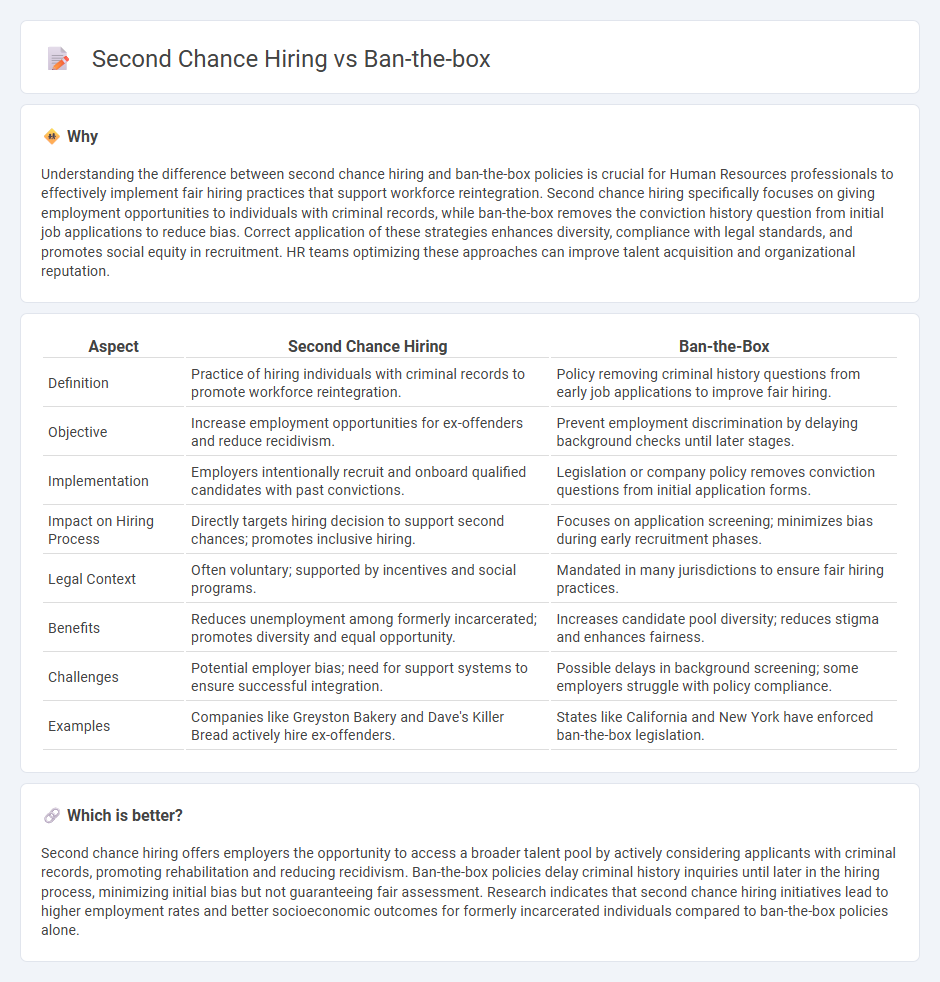
Second chance hiring focuses on providing employment opportunities to individuals with criminal records, aiming to reduce recidivism and support workforce reintegration. Ban-the-box policies remove the criminal history question from job applications to ensure fair hiring practices and prevent initial discrimination. Explore how these strategies impact diversity, inclusion, and talent acquisition in human resources.
Why it is important
Understanding the difference between second chance hiring and ban-the-box policies is crucial for Human Resources professionals to effectively implement fair hiring practices that support workforce reintegration. Second chance hiring specifically focuses on giving employment opportunities to individuals with criminal records, while ban-the-box removes the conviction history question from initial job applications to reduce bias. Correct application of these strategies enhances diversity, compliance with legal standards, and promotes social equity in recruitment. HR teams optimizing these approaches can improve talent acquisition and organizational reputation.
Comparison Table
| Aspect | Second Chance Hiring | Ban-the-Box |
|---|---|---|
| Definition | Practice of hiring individuals with criminal records to promote workforce reintegration. | Policy removing criminal history questions from early job applications to improve fair hiring. |
| Objective | Increase employment opportunities for ex-offenders and reduce recidivism. | Prevent employment discrimination by delaying background checks until later stages. |
| Implementation | Employers intentionally recruit and onboard qualified candidates with past convictions. | Legislation or company policy removes conviction questions from initial application forms. |
| Impact on Hiring Process | Directly targets hiring decision to support second chances; promotes inclusive hiring. | Focuses on application screening; minimizes bias during early recruitment phases. |
| Legal Context | Often voluntary; supported by incentives and social programs. | Mandated in many jurisdictions to ensure fair hiring practices. |
| Benefits | Reduces unemployment among formerly incarcerated; promotes diversity and equal opportunity. | Increases candidate pool diversity; reduces stigma and enhances fairness. |
| Challenges | Potential employer bias; need for support systems to ensure successful integration. | Possible delays in background screening; some employers struggle with policy compliance. |
| Examples | Companies like Greyston Bakery and Dave's Killer Bread actively hire ex-offenders. | States like California and New York have enforced ban-the-box legislation. |
Which is better?
Second chance hiring offers employers the opportunity to access a broader talent pool by actively considering applicants with criminal records, promoting rehabilitation and reducing recidivism. Ban-the-box policies delay criminal history inquiries until later in the hiring process, minimizing initial bias but not guaranteeing fair assessment. Research indicates that second chance hiring initiatives lead to higher employment rates and better socioeconomic outcomes for formerly incarcerated individuals compared to ban-the-box policies alone.
Connection
Second chance hiring and ban-the-box policies are connected through their shared goal of reducing employment barriers for individuals with criminal records. Ban-the-box laws prohibit employers from asking about criminal history on initial job applications, enabling candidates to be evaluated based on qualifications first. This approach complements second chance hiring initiatives that actively promote hiring individuals with past convictions, improving workforce diversity and reducing recidivism rates.
Key Terms
Criminal Background Disclosure
Ban-the-box policies prohibit employers from asking about criminal history on initial job applications, promoting fair chance hiring by delaying background inquiries. Second chance hiring actively encourages employers to consider individuals with criminal records by recognizing their potential beyond past convictions. Explore how these initiatives reshape employment opportunities and reduce barriers for justice-involved job seekers.
Fair Chance Employment
Ban-the-box laws remove criminal history questions from initial job applications to increase Fair Chance Employment by reducing bias against formerly incarcerated individuals. Second Chance Hiring expands opportunities further by actively recruiting and hiring candidates with criminal records, emphasizing rehabilitation and workforce inclusion. Explore how these policies transform hiring practices and promote equitable employment outcomes.
Rehabilitation
Ban-the-box policies remove criminal history questions from job applications to reduce barriers for individuals with past convictions, promoting fair employment opportunities. Second chance hiring goes further by actively encouraging employers to recruit and support candidates with criminal records, aiming to facilitate successful reintegration and reduce recidivism. Explore how these strategies contribute to rehabilitation and workforce inclusion by learning more about their impacts and implementation.
Source and External Links
Ban the Box - Wikipedia - Ban the Box is a campaign to remove criminal history questions from job applications so that ex-offenders can be evaluated based on qualifications first, with the policy originating in Hawaii in the late 1990s and now adopted in various forms across many U.S. states and private employers.
Ban the Box: U.S. Cities, Counties, and States Adopt Fair Hiring ... - As of 2021, 37 states and over 150 cities and counties have enacted Ban the Box policies that remove questions about arrest and conviction records from job applications, aiming to provide fair chance hiring by addressing barriers for justice-involved individuals.
The Limits of Ban-the-Box Legislation - Ban the Box laws delay inquiries into criminal history until after conditional job offers are made to reduce employment barriers and stigmas, with research showing mixed outcomes that depend on factors like race and job sector.
 dowidth.com
dowidth.com